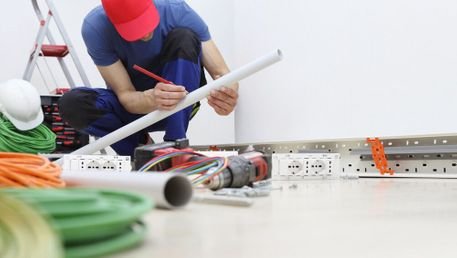Our Company Services

Electrical Installation
An electrical installation refers to the arrangement and setup of electrical wiring, switches, outlets, panels, and other components necessary to distribute electricity safely and efficiently within a building or structure. This installation includes the placement and connection of electrical devices such as lights, appliances, and machinery to ensure they receive the required power supply. Electrical installations are designed following safety codes and standards to minimize the risk of electrical hazards like shocks, fires, or short circuits. Proper installation is essential for reliable electricity distribution and the safe operation of electrical equipment within homes, commercial buildings, and industrial facilities.
Repair and Troubleshooting
Electrical issues can arise over time. Whether it’s a malfunctioning outlet, flickering lights, or a tripping circuit breaker, electrical service professionals can quickly identify and resolve these problems, restoring safety and functionality to your home.Once the issue is identified, repairs can range from replacing faulty wiring, switches, or outlets to fixing or replacing damaged components such as circuit breakers or transformers. Safety protocols are strictly followed during repairs to prevent electrical hazards.Effective repair and troubleshooting require a combination of technical knowledge, experience, and adherence to safety standards.


Safety Inspection
A safety inspection for electrical services involves a thorough assessment of an electrical system to ensure it complies with safety standards and regulations, aiming to prevent hazards and promote a safe operating environment. Here’s a description:A safety inspection for electrical services is a comprehensive evaluation of the electrical infrastructure within a building or facility to identify potential safety risks and ensure compliance with electrical codes and standards. This inspection encompasses a detailed examination of wiring, distribution panels, outlets, switches, and other electrical components
Upgrades and Modernization
As technology advances, homes often require electrical upgrades. This can include adding more outlets, upgrading service panels, or integrating smart home technologies. Upgrades not only enhance convenience but also contribute to energy efficiency. Upgrade and modernization for electrical services involve improving existing electrical systems to enhance efficiency, reliability, and safety while incorporating newer technologies and practices.


Emergency Service
Emergency services for electrical systems involve providing immediate response and support to address electrical issues and restore functionality during unexpected situations or power-related emergencies. Here’s a description:Emergency services for electrical systems are critical for promptly addressing electrical failures, outages, or safety concerns that require urgent attention to prevent disruptions or hazards. These services are available 24/7 and involve rapid response by qualified electricians or technicians.
Energy Efficiency Solutions
.
Energy-efficient solutions for electrical services focus on reducing energy consumption, lowering utility costs, and minimizing environmental impact while maintaining reliable electrical performance. Here’s a description Energy-efficient solutions for electrical services involve implementing technologies and practices that optimize energy use within a building or facility. These solutions aim to maximize efficiency and reduce wasted energy, resulting in lower operational costs and reduced carbon footprint. Key components of energy-efficient electrical services include:


Home Automation Integration
Home automation integration refers to the seamless incorporation of smart technologies and automated systems into various aspects of a home. This involves connecting and synchronizing devices and systems to enhance efficiency, convenience, and control. Common components of home automation integration include:
Code Compliance and Permits
Code compliance refers to adherence to building codes, which are sets of regulations specifying minimum standards for construction, design, and safety.Compliance ensures structures meet safety, structural, and environmental requirements, promoting the well-being of occupants and the community.

